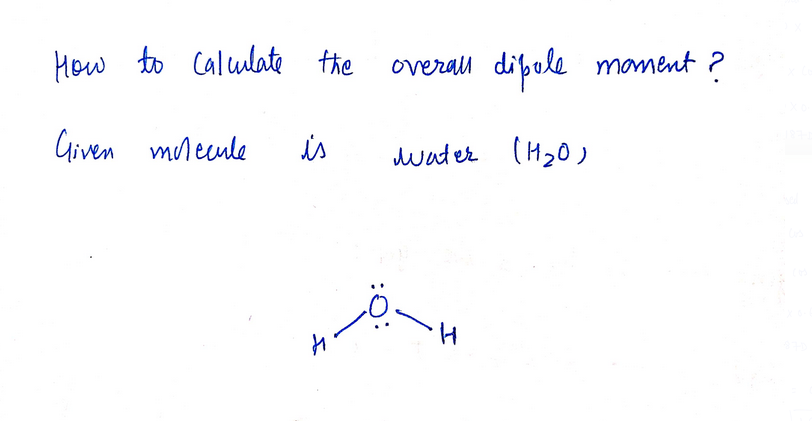Chemistry
10th Edition
ISBN:9781305957404
Author:Steven S. Zumdahl, Susan A. Zumdahl, Donald J. DeCoste
Publisher:Steven S. Zumdahl, Susan A. Zumdahl, Donald J. DeCoste
Chapter1: Chemical Foundations
Section: Chapter Questions
Problem 1RQ: Define and explain the differences between the following terms. a. law and theory b. theory and...
Related questions
Question
100%
How do i calculate the overall dipole moment?

Transcribed Image Text:### Understanding the Polarity of Water (H₂O)
**Molecular Geometry and Polarity**
The diagram illustrates the molecular structure and polarity of water (H₂O). Water is a polar molecule due to its molecular shape and the electronegativity difference between the oxygen and hydrogen atoms.
**Structure Description:**
- **Central Oxygen Atom:**
- Represented by a red sphere.
- **Hydrogen Atoms:**
- Represented by two white spheres connected to the oxygen atom.
**Numerical Values:**
- The electronegativity values are shown as follows:
- Oxygen to Hydrogen bonds each have a value of 2.1.
**Bond Dipoles:**
- **Bond Dipole Arrows:**
- Illustrated by arrows pointing from the hydrogen atoms towards the oxygen atom.
- These arrows indicate the direction of the bond dipole, which occurs because oxygen is more electronegative than hydrogen.
**Overall Dipole Moment:**
- The overall dipole moment of the molecule is depicted by a larger arrow pointing upwards from the oxygen, labeled with the value 3.5. This suggests that the water molecule has a net dipole moment, contributing to its polarity.
**Conclusion:**
- Due to the asymmetric shape and the differing electronegativities between the oxygen and hydrogen atoms, water has a strong overall dipole moment, making it a polar molecule. This polarity leads to water's unique properties, such as its ability to dissolve many substances.
Expert Solution
Step 1

Step by step
Solved in 3 steps with 3 images

Knowledge Booster
Learn more about
Need a deep-dive on the concept behind this application? Look no further. Learn more about this topic, chemistry and related others by exploring similar questions and additional content below.Recommended textbooks for you

Chemistry
Chemistry
ISBN:
9781305957404
Author:
Steven S. Zumdahl, Susan A. Zumdahl, Donald J. DeCoste
Publisher:
Cengage Learning

Chemistry
Chemistry
ISBN:
9781259911156
Author:
Raymond Chang Dr., Jason Overby Professor
Publisher:
McGraw-Hill Education

Principles of Instrumental Analysis
Chemistry
ISBN:
9781305577213
Author:
Douglas A. Skoog, F. James Holler, Stanley R. Crouch
Publisher:
Cengage Learning

Chemistry
Chemistry
ISBN:
9781305957404
Author:
Steven S. Zumdahl, Susan A. Zumdahl, Donald J. DeCoste
Publisher:
Cengage Learning

Chemistry
Chemistry
ISBN:
9781259911156
Author:
Raymond Chang Dr., Jason Overby Professor
Publisher:
McGraw-Hill Education

Principles of Instrumental Analysis
Chemistry
ISBN:
9781305577213
Author:
Douglas A. Skoog, F. James Holler, Stanley R. Crouch
Publisher:
Cengage Learning

Organic Chemistry
Chemistry
ISBN:
9780078021558
Author:
Janice Gorzynski Smith Dr.
Publisher:
McGraw-Hill Education

Chemistry: Principles and Reactions
Chemistry
ISBN:
9781305079373
Author:
William L. Masterton, Cecile N. Hurley
Publisher:
Cengage Learning

Elementary Principles of Chemical Processes, Bind…
Chemistry
ISBN:
9781118431221
Author:
Richard M. Felder, Ronald W. Rousseau, Lisa G. Bullard
Publisher:
WILEY